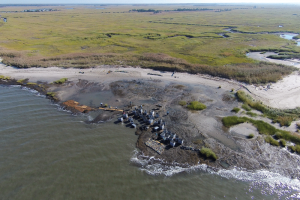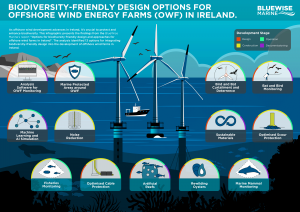
Making offshore wind work for nature and climate in Ireland
BlueWise Marine’s recent study on nature-positive design identified 13 effective solutions ready for use in offshore wind projects in Ireland.
GALWAY, GALWAY, IRELAND, September 17, 2024 /EINPresswire.com/ -- BlueWise Marine’s study on nature-positive design identified 13 effective solutions ready for use in offshore wind projects in Ireland. However, clear standards, effective monitoring, and detailed guidance for developers are needed.Offshore wind energy development is especially well-suited to Ireland’s steady strong winds and extensive coastlines, making it crucial for reducing the country’s greenhouse gas emissions. For a nation heavily dependent on oil and gas imports, investing in offshore wind energy infrastructure also offers a path to energy security, helping to stabilise energy prices for consumers.
As offshore wind development progresses in Ireland, it’s vital to prioritise protecting and enhancing biodiversity, which underpins our economy and society. Irish and EU laws already recommend or require integrating biodiversity considerations into offshore wind projects. Many companies like RWE, SSE Renewables, EDF, Statkraft, and Ørsted have adopted biodiversity-friendly policies.
Nature-positive design for offshore wind in Ireland
Nature-Based Design, sometimes called Nature-Inclusive Design, is one of the Nature-Based Solutions (NBS) and involves creating structures inspired by natural elements to enhance habitats for species affected by offshore wind farms (OWFs). These designs can be integrated into or added onto wind farm infrastructure.
Our recent study “Options for Biodiversity-friendly designs and approaches for offshore wind farms in Ireland” identified 13 nature-based solutions with highest potential for use during Ireland’s Phase One offshore wind energy projects and beyond that, during the implementation of the Future Framework.
These solutions are well-suited to species and habitats found in Ireland and were selected for their high potential effectiveness. Additionally, these measures generally have high level of maturity and have been tried and tested in ecological restoration, conservation and enhancement projects beyond the scope of offshore wind.
Nature-based solutions and initiatives are rarely, if ever, mutually exclusive, and could often be combined. For instance, a lobster hatchery supplying juveniles to an OWF can be combined with installing a scour protection layer optimised for juvenile and adult lobsters, while ecological modelling can inform monitoring initiatives and vice versa.
Using a systematic review and gap analysis, BlueWise Marine team assessed 123 global NBS projects for their suitability in Ireland. Along with the 13 solutions with highest potential, we identified other promising options that could be implemented as our knowledge and experience of offshore wind NBS grows.
Implementation matters
While Ireland has policies supporting biodiversity, practical standards, incentives, and requirements still need to be developed. For instance, the Offshore Wind Delivery Taskforce (OWDT) could require the integration of NBS at the planning and permitting stages, ensuring designs are informed by early environmental impact assessments and surveys.
Another key area is improving monitoring guidelines for species like bats, fish, and benthic communities, as well as filling data gaps on migration routes for birds and marine mammals. Effective monitoring is essential for developing robust mitigation measures and preventing unforeseen ecological impacts. The new EU Life Programme project to develop a single platform for Biodiversity Data could be an opportunity to bridge this gap.
Finally, to support developers, a catalogue or national roadmap could be created, providing guidance on the best NBS initiatives for specific projects. Such a roadmap would describe the legal framework, shortlist key species, outline risks, provide ecological and technical considerations as well as a detailed cost breakdown. Similar resources have been produced in the Netherlands, the US and the UK.
Moving forward
While high-level in nature, our report emphasises that each project will require a tailored design approach with extensive stakeholder consultation.
Nature-inclusive designs can restore degraded habitats, boost ecological functions, and promote biodiversity. Though still relatively novel with some data gaps, these approaches hold a promise of nature-positive offshore wind development in Ireland.
Download the report Executive Summary and explore the solutions further at: https://bluewisemarine.ie/
Ekaterina Bessonova
BlueWise Marine
+353 87 947 4380
ekaterina.bessonova@bluewisemarine.ie
Visit us on social media:
X
LinkedIn
Distribution channels: Business & Economy, Energy Industry, Environment, Politics, Science
Legal Disclaimer:
EIN Presswire provides this news content "as is" without warranty of any kind. We do not accept any responsibility or liability for the accuracy, content, images, videos, licenses, completeness, legality, or reliability of the information contained in this article. If you have any complaints or copyright issues related to this article, kindly contact the author above.
Submit your press release


